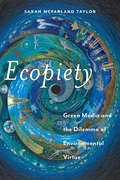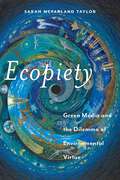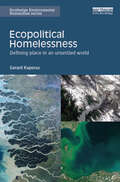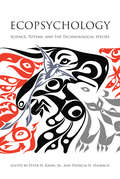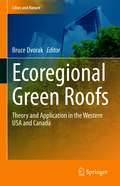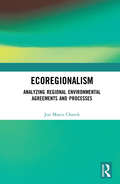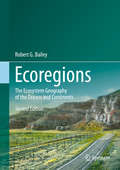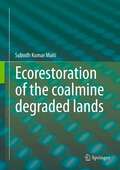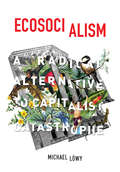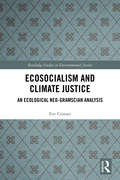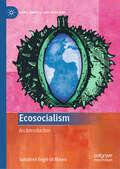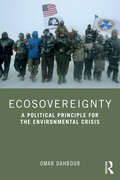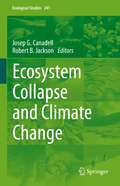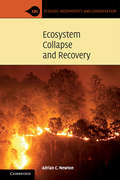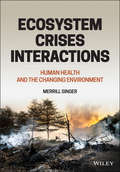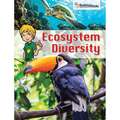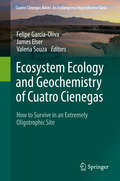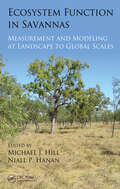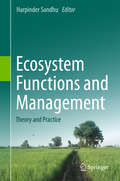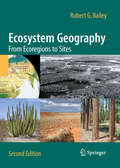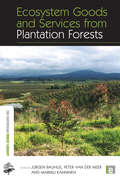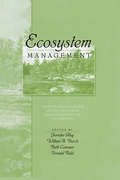- Table View
- List View
Ecopiety: Green Media and the Dilemma of Environmental Virtue (Religion and Social Transformation #1)
by Sarah McFarland TaylorTackles a human problem we all share―the fate of the earth and our role in its future Confident that your personal good deeds of environmental virtue will save the earth? The stories we encounter about the environment in popular culture too often promote an imagined moral economy, assuring us that tiny acts of voluntary personal piety, such as recycling a coffee cup, or purchasing green consumer items, can offset our destructive habits. No need to make any fundamental structural changes. The trick is simply for the consumer to buy the right things and shop our way to a greener future.It’s time for a reality check. Ecopiety offers an absorbing examination of the intersections of environmental sensibilities, contemporary expressions of piety and devotion, and American popular culture. Ranging from portrayals of environmental sin and virtue such as the eco-pious depiction of Christian Grey in Fifty Shades of Grey, to the green capitalism found in the world of mobile-device “carbon sin-tracking” software applications, to the socially conscious vegetarian vampires in True Blood, the volume illuminates the work pop culture performs as both a mirror and an engine for the greening of American spiritual and ethical commitments. Taylor makes the case that it is not through a framework of grim duty or obligation, but through one of play and delight, that we may move environmental ideals into substantive action.
Ecopiety: Green Media and the Dilemma of Environmental Virtue (Religion and Social Transformation #1)
by Sarah McFarland TaylorTackles a human problem we all share―the fate of the earth and our role in its future Confident that your personal good deeds of environmental virtue will save the earth? The stories we encounter about the environment in popular culture too often promote an imagined moral economy, assuring us that tiny acts of voluntary personal piety, such as recycling a coffee cup, or purchasing green consumer items, can offset our destructive habits. No need to make any fundamental structural changes. The trick is simply for the consumer to buy the right things and shop our way to a greener future.It’s time for a reality check. Ecopiety offers an absorbing examination of the intersections of environmental sensibilities, contemporary expressions of piety and devotion, and American popular culture. Ranging from portrayals of environmental sin and virtue such as the eco-pious depiction of Christian Grey in Fifty Shades of Grey, to the green capitalism found in the world of mobile-device “carbon sin-tracking” software applications, to the socially conscious vegetarian vampires in True Blood, the volume illuminates the work pop culture performs as both a mirror and an engine for the greening of American spiritual and ethical commitments. Taylor makes the case that it is not through a framework of grim duty or obligation, but through one of play and delight, that we may move environmental ideals into substantive action.
Ecopolitical Homelessness: Defining place in an unsettled world (Routledge Environmental Humanities)
by Gerard KuperusWhile our world is characterized by mobility, global interactions, and increasing knowledge, we are facing serious challenges regarding the knowledge of the places around us. We understand and navigate our surroundings by relying on advanced technologies. Yet, a truly knowledgeable relationship to the places where we live and visit is lacking. This book proposes that we are utterly lost and that the loss of a sense of place has contributed to different crises, such as the environmental crisis, the immigration crisis, and poverty. With a rising number of environmental, political, and economic displacements the topic of place becomes more and more relevant and philosophy has to take up this topic in more serious ways than it has done so far. To counteract this problem, the book provides suggestions for how to think differently, both about ourselves, our relationship to other people, and to the places around us. It ends with a suggestion of how to understand ourselves in an eco-political community, one of humans and other living beings as well as inanimate objects. This book will be of great interest to researchers and students of environmental ethics and philosophy as well as those interested in the environmental humanities more generally.
Ecopopulism: Toxic Waste and the Movement for Environmental Justice
by Andrew SzaszThis book reconstructs the growth of a powerful movement around the question of toxic waste, following the issue as it moves from the world of "official" policymaking in Washington, onto the nation's television screens and into popular consciousness, and then into America's neighborhoods, spurring the formation of thousands of local, community-based groups.
Ecopsychology: Science, Totems, and the Technological Species
by Jr. Peter H. Kahn Patricia H. HasbachAn ecopsychology that integrates our totemic selves—our kinship with a more than human world—with our technological selves.We need nature for our physical and psychological well-being. Our actions reflect this when we turn to beloved pets for companionship, vacation in spots of natural splendor, or spend hours working in the garden. Yet we are also a technological species and have been since we fashioned tools out of stone. Thus one of this century's central challenges is to embrace our kinship with a more-than-human world—"our totemic self"—and integrate that kinship with our scientific culture and technological selves.This book takes on that challenge and proposes a reenvisioned ecopsychology. Contributors consider such topics as the innate tendency for people to bond with local place; a meaningful nature language; the epidemiological evidence for the health benefits of nature interaction; the theory and practice of ecotherapy; Gaia theory; ecovillages; the neuroscience of perceiving natural beauty; and sacred geography. Taken together, the essays offer a vision for human flourishing and for a more grounded and realistic environmental psychology.
Ecoregional Green Roofs: Theory and Application in the Western USA and Canada (Cities and Nature)
by Bruce DvorakThis book studies the application of green roofs in ecoregions of the western United States and Canada. While green roofs were intended to sustain local or regional vegetation, this volume describes how green roofs in their modern form are typically planted with a low-diversity mix of sedums from Europe or Asia. The authors demonstrate how in the western USA and Canada many green roofs have been designed with native plants and have been found to thrive.Part I of this book covers theory and an overview of ecoregions and their implications for green roofs. In Part II vegetation from prairies, deserts, montane meadows, coastal meadows, and scrub and sub-alpine habitats are explored on seventy-three ecoregional green roofs. Case studies explore design concepts, materials, watering and maintenance, wildlife, plant species, and lessons learned. Part III covers an overview of ecoregional green roofs and a future outlook.This book is aimed at professionals, designers, researchers, students and educators with an interest in green roofs and the preservation of biodiversity.
Ecoregionalism: Analyzing Regional Environmental Agreements and Processes
by Jon Marco ChurchThis book provides a comprehensive understanding of environmental regionalism at the international level, analyzing the concept and identifying recurring patterns from six in-depth case studies. While ecoregions or environmental regions are defined on ecological boundaries rather than administrative criteria, ecoregionalism is the idea that regional dynamics should cluster around ecoregions, while ecoregionalization is the tendency of regional dynamics to cluster around ecoregions. Focusing on the international level, this book presents six cases of ecoregional processes from around the world and the regional environmental agreements: two are terrestrial, the Alps and the Andes; two are marine, the Mediterranean Sea and the Baltic Sea; two are related to freshwater ecosystems: the Amu Darya in Central Asia and the Great Lakes in North America. The book analyzes both ecoregional processes focused on the environment, as well as intersectoral ecoregional processes. The case studies are analyzed based on the ecoregional governance framework, developed by the author for this book. Despite the diversity of context, the similarity of the governance system of the six cases is striking. Several recurring patterns have been identified, which may also extend to the subnational level. They are not design principles, but may be taken into consideration for the design or redesign of current and future regional environmental agreements and processes. This book will be of great interest to students and scholars of environmental politics, natural resource management, spatial planning and international relations.
Ecoregions
by Robert G. BaileyGlobal warming and human-driven impacts are changing the World's ecological zones. This book applies the principles described in Bailey's Ecosystem Geography: From Ecoregions to Sites, 2nd ed. (Springer 2009, 1st ed. 1996) to describe and characterize the major terrestrial and aquatic ecological zones of the Earth. Bailey's system for classifying these zones has been adopted by major organizations such as the U. S. Forest Service and The Nature Conservancy and this book is a significant contribution to a long tradition of classifying and studying the world's ecological regions or ecoregions. It includes two color maps that show the major ecoregions of the continents and oceans. Also included are: - 106 illustrations with 55 in full color - A new chapter on mountains is included. - There are new sections that address concerns about how eco regions are changing under the relentless influence of humans and climate change - Another new feature is the discussion of using eco regional patterns to transfer research results and select sites for detecting climate change effects on ecosystem distribution - Use of ecoregional patterns to design monitoring networks and sustainable landscapes - Fire regimes in different regional ecosystems and their management implications.
Ecorestoration of the coalmine degraded lands
by Subodh Kumar MaitiThe book adopts an application-oriented approach for ecorestoration of coalmine degraded. The theoretical aspects of ecorestoration, and steps involved in ecorestoration process and experimental aspects of thorough analytical procedures have been discussed in detail. It emphasizes on the types of mining, land degradation, and biodiversity conservation while giving details of technical and biological steps, topsoil management, selection of plant species, seeding, nursery practices; adoption of innovative approaches like mulching, biofertlizer application, hydroseeding, superabsorbent; use of grass-legume mix; monitoring and aftercare of reclaimed sites; the indicators of sustainable ecorestoration; and Rules and Acts implemented and followed across the world. Best ecorestoration practices, mine closure issues, collection, laboratory analysis and interpretation of minesoil and topsoil samples, monitoring biological parameters, litterfall and tree growth analysis, erosion management, design of drainage and sedimentation retention basin, and brief description of tree species with identifying character for field people are all part of the book. [Message by Prominent Academician] It is now urgent that methods of coal mining be integrated with engineering for ecorestoration because the larger society will not accept devastated waste land. A book, coming out from the hands of one of the persistent researchers of the field, cannot be more timely. Jayanta Bhattacharya, PhD FNAE Professor, Department of Mining Engineering Indian Institute of Technology, Kharagpur-721302, India.
Ecosocialism
by Michael LöwyCapitalism is killing the planet, and the preservation of a natural environment favorable to human life requires a radical alternative. In this new collection of essays, long time revolutionary and environmental activist Michael Löwy offers a vision of ecosocialist transformation. This vision combines an understanding of the destructive logic of the capitalist system with an appreciation for ongoing struggles, particularly in Latin America.
Ecosocialism and Climate Justice: An Ecological Neo-Gramscian Analysis (Routledge Studies in Environmental Justice)
by Eve CroeserThis book investigates the broader climate movement to contextualise the role played by its climate justice wing, focusing specifically on the theoretical and practical contributions of ecosocialists. Ecosocialism and Climate Justice provides an account of the shift from the Holocene to the Anthropocene in the context of the global spread of capitalist relations of production. Croeser begins by critically analysing the root causes of anthropogenic climate change and identifies the origins and development of the current climate movement within civil society. She then focuses on the climate justice movement, analysing the ways in which anthropogenic global warming may be challenged in a way that is socially just. Overall, this book provides further insight into the effectiveness of ecosocialist theory and activism in the context of existing global, national and local power relationships. This book will be of great interest to students and scholars of climate justice, climate politics, critical global political economy studies and environmental activism.
Ecosocialism: An Introduction (Marx, Engels, and Marxisms)
by Salvatore Engel-Di MauroThis book offers an extensive critical overview of eco-socialism, one of the most generative and significant aspects of contemporary debates within socialism. Marxism has played a foundational role in the development of ecosocialism since its inception and has also led to critical reflections on the 20th century Marxism and ecological interpretation of Marxist writings. Despite the relevance of ecosocialism to the pressing debates on the ecological crisis and the growing literature on ecosocialism, there has not been a comprehensive account on ecosocialism and its variations. This volume seeks to fill this important gap and to pave the way for a more systematic development of this emerging paradigm. The book not only engages with a critique of other non-socialist ecological schools of thought in defence of ecosocialism, but also provides a critical overview of debates within ecosocialism and of ecosocialism itself. The latter includes an appraisal of ecosocialism in Bolivarian Venezuela and the implications of current efforts in the People's Republic of China to build an ecological civilisation. Furthermore, the book contains a crucial discussion about the relation between eco-socialism and indigenous studies and movements.
Ecosovereignty: A Political Principle for the Environmental Crisis
by Omar DahbourIn this book, Omar Dahbour develops the idea of ecosystem sovereignty, calling for a reinterpretation of some essential concepts in political philosophy, including territoriality, self-determination, peoplehood, and sovereignty, in order to make the case for peoples’ rights to protect and maintain their natural environments. In doing so, he theorizes current and historical struggles against resource extractions and land grabs, especially by food sovereignty and indigenous rights movements.The basic idea of ecosovereignty is that peoples living in relation to particular ecosystems have a collective right to ultimate authority over those systems and the resources they contain—provided they manage them sustainably. Dahbour argues that this authority has a legitimacy that overrides that of larger states, at least with regard to matters of environmental management. Ecosovereignty claims may strengthen challenges by peoples to states and corporations seeking to control and transform lands and waters for development, against the wishes of their inhabitants. Dahbour hopes the idea will provide a powerful tool for halting extractivism and ecocide, along with the extreme violence that these processes use against farming, indigenous peoples, and nature.Connecting political and environmental philosophy in an innovative way, Ecosovereignty: A Political Principle for the Environmental Crisis will keep scholars and students informed about an increasingly important topic.
Ecosystem Collapse and Climate Change (Ecological Studies #241)
by Robert B. Jackson Josep G. CanadellHuman-driven greenhouse emissions are increasing the velocity of climate change and the frequency and intensity of climate extremes far above historical levels. These changes, along with other human-perturbations, are setting the conditions for more rapid and abrupt ecosystem dynamics and collapse.This book presents new evidence on the rapid emergence of ecosystem collapse in response to the progression of anthropogenic climate change dynamics that are expected to intensify as the climate continues to warm. Discussing implications for biodiversity conservation, the chapters provide examples of such dynamics globally covering polar and boreal ecosystems, temperate and semi-arid ecosystems, as well as tropical and temperate coastal ecosystems.Given its scope, the volume appeals to scientists in the fields of general ecology, terrestrial and coastal ecology, climate change impacts, and biodiversity conservation.
Ecosystem Collapse and Recovery (Ecology, Biodiversity and Conservation)
by Adrian C. NewtonThere is a growing concern that many important ecosystems, such as coral reefs and tropical rain forests, might be at risk of sudden collapse as a result of human disturbance. At the same time, efforts to support the recovery of degraded ecosystems are increasing, through approaches such as ecological restoration and rewilding. Given the dependence of human livelihoods on the multiple benefits provided by ecosystems, there is an urgent need to understand the situations under which ecosystem collapse can occur, and how ecosystem recovery can best be supported. To help develop this understanding, this volume provides the first scientific account of the ecological mechanisms associated with the collapse of ecosystems and their subsequent recovery. After providing an overview of relevant theory, the text evaluates these ideas in the light of available empirical evidence, by profiling case studies drawn from both contemporary and prehistoric ecosystems. Implications for conservation policy and practice are then examined.
Ecosystem Crises Interactions: Human Health and the Changing Environment
by Merrill SingerExplores the human impacts on environment that lead to serious ecological crises, an innovative resource for students, professionals, and researchers alike Ecosystem Crises Interaction: Human Health and the Changing Environment provides a timely and innovative framework for understanding how negative human activity impacts the environment, and how seemingly disparate factors connect to, and magnify, hazardous consequences under a changing climate. Presenting a coherent, holistic perspective to the subject, this compelling textbook and reference examines the diverse, often unexpected links that connect our complex world in context of global climate change. The text illustrates how eco-crisis interaction—the synergistic interface of two or more environmental events or pollutants—can multiply to produce harmful health effects that are greater than their additive impact. This concept is highlighted through numerous real and relatable examples, from the use of sediment rock in hydraulic and drinking water filtration systems, to the connections between human development and crises such as deforestation, emergent infectious diseases, and global food insecurity. Throughout the text, specific examples present opportunities to consider broader questions about the extinction of species, populations, and ways of life. Presenting a balanced investigation of the interaction of contemporary ecological dangers, human behavior, and health, this unique resource: Explores how complex interactions between global warming and anthropogenic impairments magnify the diverse ecological perils and threats facing humans and other species Discusses roadblocks to addressing environmental risk, such as global elite polluters, the organized denial of climate change, and deliberate environmental disruption for financial gain Describes how the production and use of fossil fuels are driving a significant rise in carbon dioxide and other pollutants in the atmosphere and in the oceans Illustrates how industrial production is contributing to an array of environmental crises, including fuel spills, waste leakages, and loss of biodiversity Examines the critical ecosystems that are at risk from interacting stressors of human origin Ecosystem Crises Interaction: Human Health and the Changing Environment is an ideal textbook for advanced undergraduate and graduate students in courses including public and allied health, environmental studies, medical ecology, medical anthropology, and geo-health, and a valuable reference for researchers, practitioners, and policy makers in fields such as environmental health, global and planetary health, public health, climate change, and medical social science.
Ecosystem Diversity: Below-Grade Reader (Building Blocks of Science Literacy Series)
by Linda CernakLexile range: 320L–470L. This reader exposes students to habitats in their own backyard and around the world, and the organisms inhabiting them. Topics include: Plants and Animals Everywhere!; Water Habitats; Land Habitats; the Science and Engineering Practices that relate to asking questions and developing answers; and a day in the life of a zoologist.
Ecosystem Ecology
by David G. Raffaelli Christopher L. J. FridWhat can ecological science contribute to the sustainable management and conservation of the natural systems that underpin human well-being? Bridging the natural, physical and social sciences, this book shows how ecosystem ecology can inform the ecosystem services approach to environmental management. The authors recognise that ecosystems are rich in linkages between biophysical and social elements that generate powerful intrinsic dynamics. Unlike traditional reductionist approaches, the holistic perspective adopted here is able to explain the increasing range of scientific studies that have highlighted unexpected consequences of human activity, such as the lack of recovery of cod populations on the Grand Banks despite nearly two decades of fishery closures, or the degradation of Australia's fertile land through salt intrusion. Written primarily for researchers and graduate students in ecology and environmental management, it provides an accessible discussion of some of the most important aspects of ecosystem ecology and the potential relationships between them.
Ecosystem Ecology and Geochemistry of Cuatro Cienegas: How To Survive In An Extremely Oligotrophic Site (Cuatro Ciénegas Basin: An Endangered Hyperdiverse Oasis Ser.)
by Valeria Souza Felipe García-Oliva James ElserCarbon (C), Nitrogen (N) and Phosphorus (P) are three of the most important elements used to build living beings, and their uptake from the environment is consequently essential for all organisms. Photosynthesis is the process in which plants absorb atmospheric C as they grow and convert it to biomass. However, plants acquire N and P only when these are available in the soil solution, which makes these elements the most limiting nutrients in plant growth and productivity in most ecosystems. When plant residues and roots decompose, the C, N and P they contain is transformed primarily into soil organic matter (SOM) or C and N can release to the atmosphere. Recent interest on the global C, N and P cycles has focused attention on the different proportion of terrestrial C, N and P stored in different ecosystem pools. Cuatro Cienegas represents an exceptional place, since the plants are not the base of the food web, they are the microbial community, that recycle the elements essential for life. In this book we describe how this is an analog of early Earth.
Ecosystem Function in Savannas: Measurement and Modeling at Landscape to Global Scales
by Michael J. Hill Niall P. HananFascinating and diverse, savanna ecosystems support a combination of pastoral and agropastoral communities alongside wild and domestic herbivores that can be found nowhere else. This diversity has made the study of these areas problematic. Ecosystem Function in Savannas: Measurement and Modeling at Landscape to Global Scales addresses some of the d
Ecosystem Functioning
by Kurt JaxIn the face of decreasing biodiversity and ongoing global changes, maintaining ecosystem functioning is seen both as a means to preserve biological diversity as well as for safeguarding human well-being by securing the services ecosystems provide. The concept today is prominent in many fields of ecology and conservation biology, such as biodiversity research, ecosystem management, or restoration ecology. Although the idea of ecosystem functioning is important, the concept itself remains rather vague and elusive. This book provides a novel analysis and integrated synthesis of different approaches to conceptualising and assessing ecosystem functioning. It links the natural sciences with methodologies from philosophy and the social sciences, and introduces a new methodology for a clearer and more efficient application of ecosystem functioning concepts in practice. Special emphasis is laid on the social dimensions of the concept and the ways it influences research practice. Several case studies relate theoretical analyses to practical application.
Ecosystem Functions and Management
by Harpinder SandhuThis is the first book to provide vital information on key local ecosystems, their functions, state of health, and their role in development in an Asian context, particularly on the Indian subcontinent. It addresses six major ecosystems on the Indian subcontinent - mountain, rural, desert, forest, urban, and freshwater - and discusses their functions, how they support livelihoods and the economy, the impacts on ecosystem services, and management issues. Asia is home to nearly one third of the global population. With massive industrialization occurring at an increasing pace to support the lifestyles of a growing population, impacts on natural ecosystems are inevitable in this region. The book also explores the concepts, theory and practice regarding these key ecosystems by linking them with the livelihoods of a large population base and subsequently illustrating their importance for sustainable development in the region. Further, by suggesting policies and ways in which these systems can be maintained and enhanced, it facilitates better management of natural resources within the ecological constraints to achieve socio-economic objectives and move towards a green economy for sustainable and equitable development in the region.
Ecosystem Geography
by Robert G. BaileyThis book outlines a system that subdivides the Earth into a hierarchy of increasingly finer-scale ecosystems that can serve as a consistent framework for ecological analysis and management. The system consists of a three-part, nested hierarchy of ecosystem units and associated mapping criteria. This new edition has been updated throughout with new text, figures, diagrams, photographs, and tables.
Ecosystem Goods and Services from Plantation Forests (The Earthscan Forest Library)
by Jurgen Bauhus Peter Van Meer Markku KanninenPlantation forests often have a negative image. They are typically assumed to be poor substitutes for natural forests, particularly in terms of biodiversity conservation, carbon storage, provision of clean drinking water and other non-timber goods and services. Often they are monocultures that do not appear to invite people for recreation and other direct uses. Yet as this book clearly shows, they can play a vital role in the provision of ecosystem services, when compared to agriculture and other forms of land use or when natural forests have been degraded. This is the first book to examine explicitly the non-timber goods and services provided by plantation forests, including soil, water and biodiversity conservation, as well as carbon sequestration and the provision of local livelihoods. The authors show that, if we require a higher provision of ecosystem goods and services from both temperate and tropical plantations, new approaches to their management are required. These include policies, methods for valuing the services, the practices of small landholders, landscape approaches to optimise delivery of goods and services, and technical issues about how to achieve suitable solutions at the scale of forest stands. While providing original theoretical insights, the book also gives guidance for plantation managers, policy-makers, conservation practitioners and community advocates, who seek to promote or strengthen the multiple-use of forest plantations for improved benefits for society. Published with CIFOR
Ecosystem Management: Adaptive Strategies For Natural Resource Organizations in the Twenty-First Century
by William BurchThis book documents some of the perceptions, strategies, and actions of natural resource agencies in the twenty-first century as they seek to respond to the changed reality influencing their policies and practices. It considers some of the responses in tools, techniques, and organizational change.
